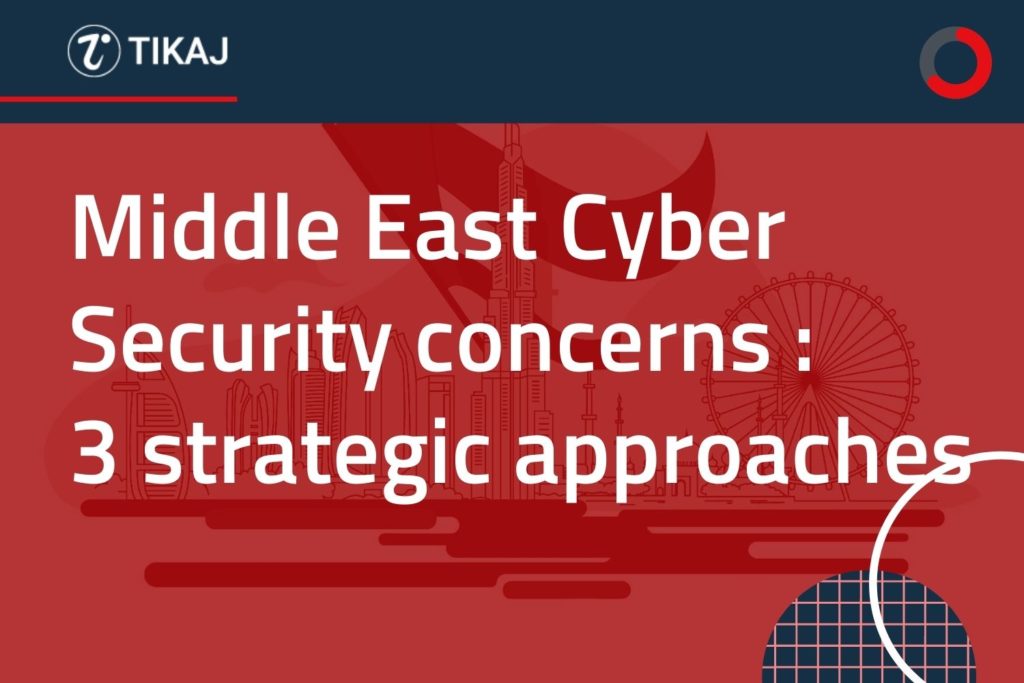Middle East Cyber Security concerns : 3 strategic approaches

The digital realm in the Middle East has seen a substantial evolution over recent years, with nations ardently embracing the perks of digitization. Yet, this digital transition has opened up a pandora’s box of cyber threats that loom over the region, making cyber security in the Middle East a topic of paramount significance.
Table of Contents
Understanding the Cyber Landscape in the Middle East
The cyber landscape in this region is as dynamic as it is perilous. The allure of burgeoning economies and the high rate of digitization in countries like the UAE, Saudi Arabia, and Bahrain attract malicious actors from across the globe. In facing these cyber adversaries, it’s not merely about safeguarding data but preserving the region’s economic stability and national security.
The temporary measure became the “New Normal” in Middle East
2021 is no different than 2020, many are still staying at home and working and there has been a continuous reliance on technologies that were auxiliary before 2020. While many thought it would be a transitory course of action, this now has shifted to be long-term planning for UAE businesses.
Over 10 million DDoS cyber attacks were recorded globally since the onset of the pandemic, including a 183% increase in the UAE alone.
Virtual Private Network and Remote Desktop Protocol administration tools have become indispensable assets to support the remote culture. Unfortunately, these tools can also be rife with a lot of vulnerabilities such as weak login credentials or unpatched software.
Know why ringing the cyber security bell in middle east is the need of the hour?
Cyber security threats are defined and redefined every day but in 2021 it took a wide jump. Digitization is still making our lives more efficient, easier but on balance brings more benefit than danger. Vulnerability assessment has always been an integral part of enterprises but today it is throwing up surprising quirks along the way.
Do you know what happened in the Middle East?
The Middle East witnessed rapid digitization and their fast track approach to a cloud-first strategy that has triggered innovations, also made enterprises operate more efficiently but not to forget it opened up unintended gateways for cyber attacks and other disruptions.
Experts have mentioned that the coming years will be riddled with more risks and growing vulnerabilities in communication, supply chain. Enterprises are investing in communication and information technology but overlooking Cyber security.
Managing Cybercrimes and digital safeguarding will and should remain the top priority in 2021 especially in the MENA region, as the region is seeing an increase in businesses.
Cybercrime is devastating the growth of the economy in the Middle East region.

So, what to do now? Reinforcing a better IT infrastructure? Indeed. Using better security tools? Indeed. Training people about cyber hacks? No, not required as we have used the “best-in-class” tools but wait, according to a report by IBM Security, human error is the main cause of 24% of all data breaches.
A strategic approach to put a full stop to these issues.
It is always better to stop the attack rather than repair the damage after the attack.
1. Continuous VAPT
In the battle against cyber threats, adopting a proactive stance rather than a reactive one makes all the difference. Continuous Vulnerability Assessment and Penetration Testing (VAPT) emerges as a quintessential strategy to fortify the cyber defenses of organizations and nations alike.
A. The Essence of Regular Assessments
Regular assessments through VAPT are akin to having regular health check-ups in a world rife with ailments. They unveil the hidden ailments (vulnerabilities) in the system, allowing for timely intervention before these ailments escalate into severe conditions (breaches).
B. Bridging the Security Gaps
The concept of zero-day vulnerabilities – unknown weak spots that hackers can exploit – is a stark reminder of the imperativeness of continuous assessments. Through VAPT, identifying and bridging these security gaps becomes a feasible endeavor, significantly lowering the odds of successful cyber-attacks.
2. Empowering the Human Firewall
Despite the sophistication of cyber threats, the human element remains a critical line of defense. The empowerment of employees through proper training and education transforms them into a robust human firewall capable of thwarting cyber adversaries.
A. The Imperative of Employee Education
Educating employees about the diverse array of cyber threats and the tactics employed by cyber adversaries equips them with the knowledge to recognize and respond to threats adeptly. It’s about fostering a culture where cybersecurity is everyone’s responsibility.
B. Cultivating a Security-Conscious Culture
A security-conscious culture transcends beyond the boundaries of the IT department, embedding cybersecurity into the core ethos of the organization. It’s about fostering a milieu where every employee, irrespective of their role, is vigilant and proactive in mitigating cyber risks.
Creating such a culture necessitates a top-down approach, where cybersecurity is championed at the executive level, permeating through every echelon of the organization. It’s about inculcating a sense of collective responsibility towards cybersecurity, where open communication and continuous learning are encouraged, and where reporting potential threats is seen as a duty rather than a choice.
You can use advance platforms to assist in automated phishing simulation, forstering security culture and creating human firewall.
3. Think About Some Cyber-insurances
In an era where cyber threats have become a grim reality, having a financial safety net is prudent. Cyber-insurance acts as a financial buffer, mitigating the economic repercussions that often accompany cyber-attacks.
Tailoring Insurance to Cyber Needs
Traditional insurance policies may fall short in covering the financial loss stemming from cyber incidents. Cyber-insurance, on the other hand, is tailored to address the unique risks associated with the digital domain. It provides a semblance of financial security, ensuring that organizations can recover with lesser fiscal strain.
The Cost of Complacency
The absence of cyber-insurance can lead to a precarious financial situation post a cyber-attack. The cost isn’t merely about the immediate financial loss; it extends to legal liabilities, loss of reputation, and the expense of bolstering cybersecurity measures post-incident. Cyber-insurance isn’t an option but a necessity in the modern business landscape, acting as a financial cushion, aiding organizations in navigating through the turbulent aftermath of cyber incidents.
Regional Spotlight
The Middle East, with its rapid digital transformation, presents a unique cyber terrain. The proactive steps taken by nations like the UAE, Saudi Arabia, and Bahrain reflect a robust commitment to fostering a secure digital ecosystem.
UAE: A Forerunner in Cyber Security
The UAE, with its ambitious Vision 2021, propels itself as a forerunner in cyber security in the Middle East. The nation’s holistic approach encompasses stringent cyber laws, state-of-the-art cyber infrastructure, and a keen emphasis on public-private partnerships to combat cyber threats.
Saudi Arabia: Bolstering Digital Defenses
Saudi Arabia, on the back of its Vision 2030, is making strides in bolstering its digital defenses. The establishment of the National Cybersecurity Authority underscores the nation’s resolve to fortify its cyber frontiers, ensuring a resilient digital economy.
Bahrain: Navigating Cyber Challenges
Bahrain’s endeavor to navigate through cyber challenges is manifested through its comprehensive cyber laws and the establishment of a dedicated cyber security center. The nation’s approach signifies a blend of regulatory measures and technological solutions to foster a secure digital ambiance.
Collaborative Efforts: The Road Ahead
The path to a secure cyber future in the Middle East isn’t a solitary endeavor but a collaborative effort. Engaging in international cooperation and regional collaborations can significantly augment the cyber resilience of the Middle Eastern nations.
International Cooperation for Stronger Security
Pooling resources, sharing intelligence, and fostering a collaborative cyber security culture on a global scale can significantly bolster the cyber defenses of nations. International cooperation paves the way for a unified front against cyber adversaries, making the cyber realm a less hospitable place for malicious actors.
Middle East’s Cyber Future
The fusion of national efforts with international collaborations spells a promising cyber future for the Middle East. It’s about creating a cyber-resilient region that not only thwarts cyber threats but fosters a secure digital growth trajectory.
Conclusion
The expedition to a secure cyber realm in the Middle East is a multifaceted endeavor. It entails a blend of proactive measures like continuous VAPT, fostering a security-conscious culture among employees, and ensuring financial resilience through cyber-insurance. Moreover, the collaborative efforts among nations, both regionally and internationally, are instrumental in navigating through the cyber challenges that lie ahead. The roadmap to a cyber-resilient Middle East is paved with challenges, yet with a concerted effort and a robust cyber security framework, a secure digital future is within reach.
More reading:






